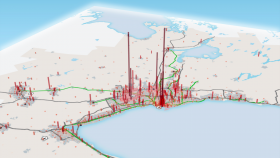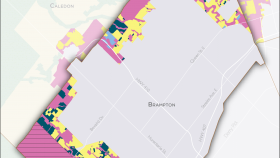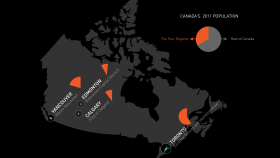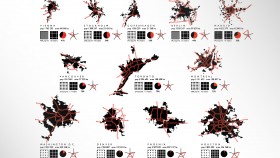Publications
Planning the Next GGH analyses and maps the geography of employment and potential disruption across the Greater Golden Horseshoe (GGH) region.
Author(s):
Report (2018)
This report contains the results of a feasibility study focusing on growth management in Ontario’s Greater Golden Horseshoe (GGH) that was designed to answer two questions: (1) What data are available to assess the capacity of and constraints on existing and planned water and wastewater systems relative to the availability of fresh water and the assimilative capacity of the region’s inland water systems? and (2) Using the available data, what types of data products and tools can be developed to better inform the allocation of growth across the Greater Golden Horseshoe?
Methodology (2018)
This Policy Brief defines and describes the Tor-York West megazone (TYW), one of three regionally, provincially, and nationally significant employment zones identified in the Neptis Foundation report Planning for Prosperity.
Author(s):
Report (2017)
This Policy Brief defines and describes the Tor-York East megazone (TYE), one of three regionally, provincially, and nationally significant employment zones identified in the Neptis Foundation report Planning for Prosperity.
Author(s):
Report (2017)
This is the fourth in a series of Briefs on the land supply for future urban development designated by municipalities across the Greater Golden Horseshoe to accommodate growth to 2031 and beyond. This Brief examines the land supply represented by Undelineated Built-up Areas (UBUAs) – rural settlements identified by the Province as being without full municipal water and wastewater servicing. Although the Growth Plan states that these small towns, villages, and hamlets should not be a focus of growth, a contradiction between the Growth Plan and a supplementary provincial document allows municipalities to count subdivisions on the edges of UBUAs as “intensification.”
Brief (2017)
This is the third in a series of Briefs on the land supply for future urban development designated by municipalities across the Greater Golden Horseshoe to accommodate growth to 2031. This Brief sums up the supply of land in (a) the Designated Greenfield Area (DGA), (b) unbuilt areas within Undelineated Built-up Areas (UBUAs), (c) land added through boundary changes to Barrie and Brantford and (d) Amendment 1 to the Growth Plan.
Brief (2017)
This report takes a closer look at the Airport Megazone, one of the three suburban employment megazones identified in the 2015 report, Planning for Prosperity, and the second largest concentration of employment in Canada.
Author(s):
Report (2016)
This is the second in a series of Briefs on the land supply for future urban development designated by municipalities across the Greater Golden Horseshoe to accommodate growth to 2031. This Brief examines the question of serviced land in the Greater Toronto and Hamilton Area (GTHA). The first looked at how much land has been built on in the past decade in the GTHA and concluded that only 20% of the total greenfield land supply until 2031 has been built on. Future Briefs will look at the rate of consumption of greenfield lands in Outer Ring municipalities beyond the Greenbelt and other lands that are part of future settlement areas, even though they are not part of the Designated Greenfield Area.
Brief (2016)
This is the first in a series of Briefs that will examine the land supply for future urban development designated by municipalities across the Greater Golden Horseshoe to accommodate growth to 2031. This Brief examines the amount of land that has been built on in the GTHA since the establishment of the Growth Plan for the Greater Golden Horseshoe in 2006.
Brief (2016)
This report maps and analyzes the dynamics of long-term structural changes – not merely cyclical market fluctuations – brought about by globalization and rapidly evolving technology in the economy of the Greater Golden Horseshoe. The report concludes that the Growth Plan for the GGH is not grounded in the reality of the region’s economic geography.
Author(s):
Report (2015)
In August 2014, newspaper headlines trumpeted the “Manhattanization” of Toronto. City Council, in the span of two days, approved 18 new high-rise apartment and office buildings in downtown Toronto, on top of 70,000 residential units already approved for construction. But what happens in downtown Toronto is only a small part of a much larger story of growth across the Greater Toronto and Hamilton Area (GTHA).
Author(s):
Brief (2015)
This report compares the 2001–2011 growth patterns of the Greater Toronto and Hamilton Area, where growth continues mainly on greenfields, and Metro Vancouver, which grew mainly through intensification, especially along frequent transit corridors.
Author(s):
Report (2015)
Neptis has prepared this discussion paper to answer three questions. (1) How does the Growth Plan for the Greater Golden Horseshoe work? (2) Is the region running out of land for development? (3) Have development patterns changed since the Plan was established? The findings are intended to contribute to the 10-year review of the Plan.
Author(s):
Report (2015)
Neptis analysis show that of the 56,200 hectares designated for urbanization between 2006 and 2031 in the Greater Toronto and Hamilton Area, only 9% was actually built on between 2006 and 2011. This finding suggests that the remainder of the land supply is likely to last well beyond 2031.
Author(s):
Analysis, Brief (2015)
Preliminary findings from the Neptis Foundation showing how four major Canadian cities have grown in the past 20 years indicate that while the populations of the Vancouver, Edmonton, Calgary, and Toronto city-regions continue to expand, the rate at which new land is being urbanized at the edge has decreased over time – sometimes quite dramatically.
Author(s):
Brief (2014)
This paper describes a method for mapping and measuring the lands designated for growth and urban expansion in the area known as the Greater Golden Horseshoe under the provisions of the Growth Plan for the Greater Golden Horseshoe.
Author(s):
Analysis, Methodology (2014)
Without cumulative information on the progress of 21 single- and upper-tier municipalities and 89 lower-tier municipalities as they adopt and implement the Plan’s requirements, there's no big picture, no sense of how municipalities compare with one other, and how the various municipal plans all add up.
Author(s):
Brief (2013)
This study, the first comprehensive review of the Plan and its outcomes to date, paints a picture of an innovative, award-winning plan under pressure and behind schedule.
Author(s):
Report (2013)
This unique view of the Toronto metropolitan region is to help its residents and policymakers visualize various connections and better understand the region.
Author(s):
Posters (2010)
Growing Cities compares three Canadian metropolitan areas: Calgary, Toronto, and Vancouver; through spatial analysis and planning policies. Highlighting that each of the cities developed distinctly given the climate of planning and provincial interests.
Author(s):
Report (2010)
This paper analyzes and describes the Province's intensification target both in principle and in practice.
Author(s):
Report (2010)
This unique view of the Toronto metropolitan region is to help its residents and policymakers visualize various connections and better understand the region.
Author(s):
Posters (2009)
Effects of retail on transportation patterns
Author(s):
Report (2009)
This study investigates how density impacts the way an area functions by studying various parameters.
Author(s):
Report (2008)
The goal of the research was to provide context for the 40% residential intensification rate target in Ontario’s Growth Plan for the Greater Golden Horseshoe.
Author(s):
Methodology (2007)
2006 Growth Plan is contextualized within the history of regional planning in Southern Ontario, answering the question which plans were influential in shaping the Places to Grow act.
Author(s):
Analysis, Commentary (2007)
The book traces the evolution of Ontario government responses to rapid population growth and outward expansion in the Toronto metropolitan region over an 80-year period.
Author(s):
Books (2007)
This paper describes a method for mapping and analysing the built-up urban area of a municipality using Landsat Thematic Mapper (TM) 5 satellite imagery and Geographic Information Systems.
Author(s):
Methodology (2007)
Urban Growth Centres and transit corridors are central to the Places to Grow plan, this report traces the importance of these two concepts historically while highlighting facets that contribute to the making of successful nodes and corridors.
Author(s):
Report (2007)
Upon the release of the Growth Plan, Neptis finds that measures advocated by the plan may not be pushing the needle far enough
Analysis, Commentary (2006)
The commentary recommends stronger regulations to control the outward expansion of urban areas, better protection for greenlands and agricultural lands, and a monitoring program to track progress towards the government's goals for growth and urbanization.
Analysis, Commentary (2005)
Based on personal interviews with 64 farmers in six locales around the region, this study sheds light on important matters such as the financial stability of farming operations, what farmers think about agricultural land preservation, and the degree of farmers’ commitment to farming. Their findings suggest that the future of farming in the region is uncertain, and may be endangered.
Author(s):
Report (2005)
Why Simcoe County plays an important role in the urban future of the region.
Author(s):
Report (2004)
Most people who live and work in the Toronto region assume that housing and travel costs vary according to where one lives. But if so, how exactly does the pattern play out in the region? Does one save, overall, by living in the suburbs?
Author(s):
Report (2004)
This is the first in a series of nine issue papers commissioned by the Neptis Foundation for consideration by the Central Ontario Smart Growth Panel established by the Government of Ontario.
Author(s):
Analysis (2003)
This is the fifth in a series of nine issue papers commissioned by the Neptis Foundation for consideration by the Central Ontario Smart Growth Panel established by the Government of Ontario.
Author(s):
Analysis (2003)
This is sixth of a series of nine issue papers commissioned by the Neptis Foundation for consideration by the Central Ontario Smart Growth Panel established by the Government of Ontario.
Author(s):
Analysis (2003)
This is the seventh in a series of nine issue papers commissioned by the Neptis Foundation for consideration by the Central Ontario Smart Growth Panel established by the Government of Ontario.
Author(s):
Analysis (2003)
The report looks at the history of Metro's Toronto's infrastructure. Expanding on water supply, sewage treatment facilities, and roads – since the Second World War, the report looks at the historical relationshipbetween the construction of the region’s physical infrastructure and the expansion of the region’s urban land use.
Author(s):
Report (2003)
More of the same type of development means more of the same type of problem
Author(s):
Report (2002)
As part of the Portrait of a Region series, this report examines the growth trends of the 1990s in the Greater Toronto Area. The study analyses planning policies and development trends relating to urban areas, agricultural areas, environmentally significant areas, and rural areas, in light of the scale and pace of change in the region, to determine whether and how quickly the region is moving towards the goal of "sustainable" development.
Author(s):
Report (2000)







































